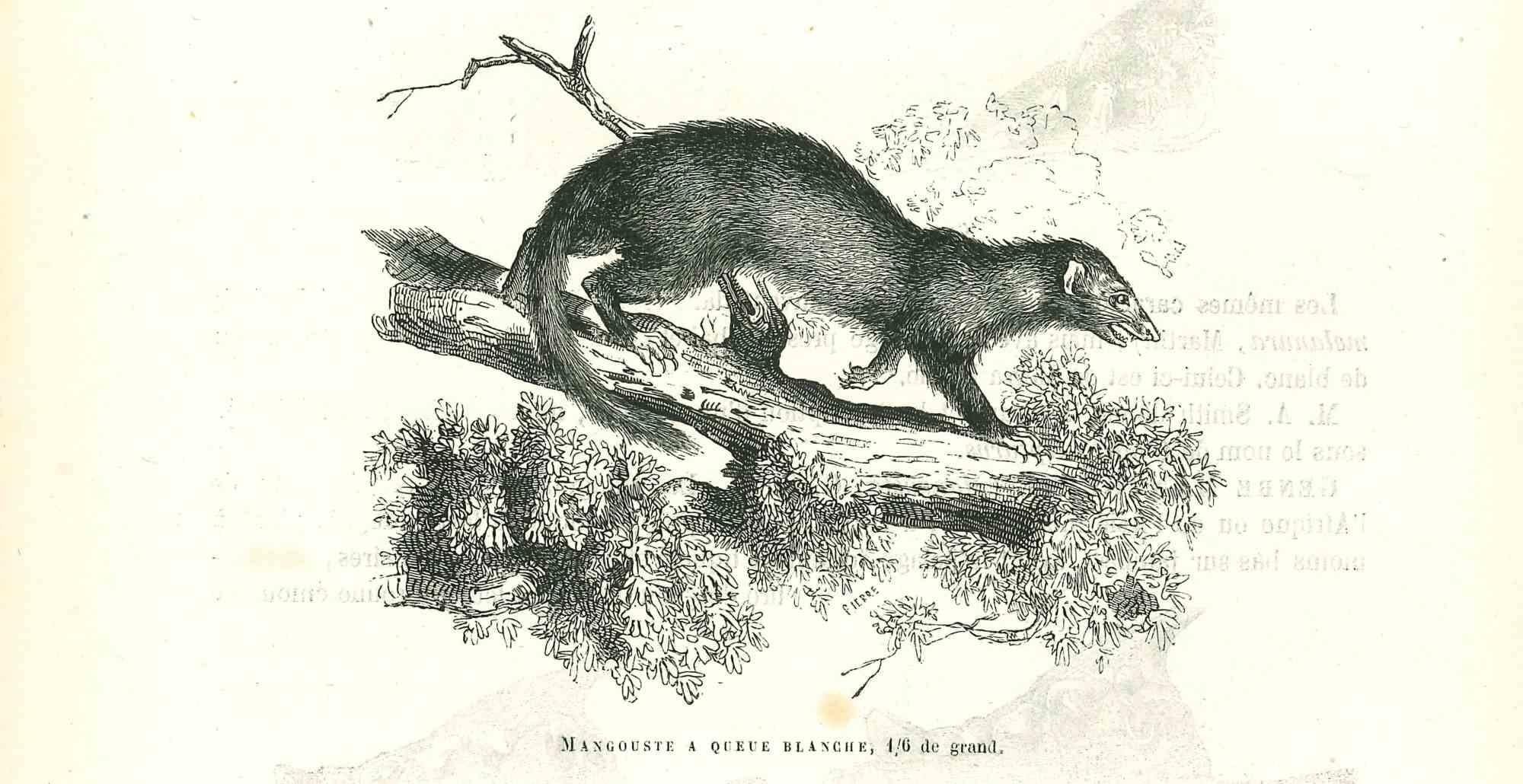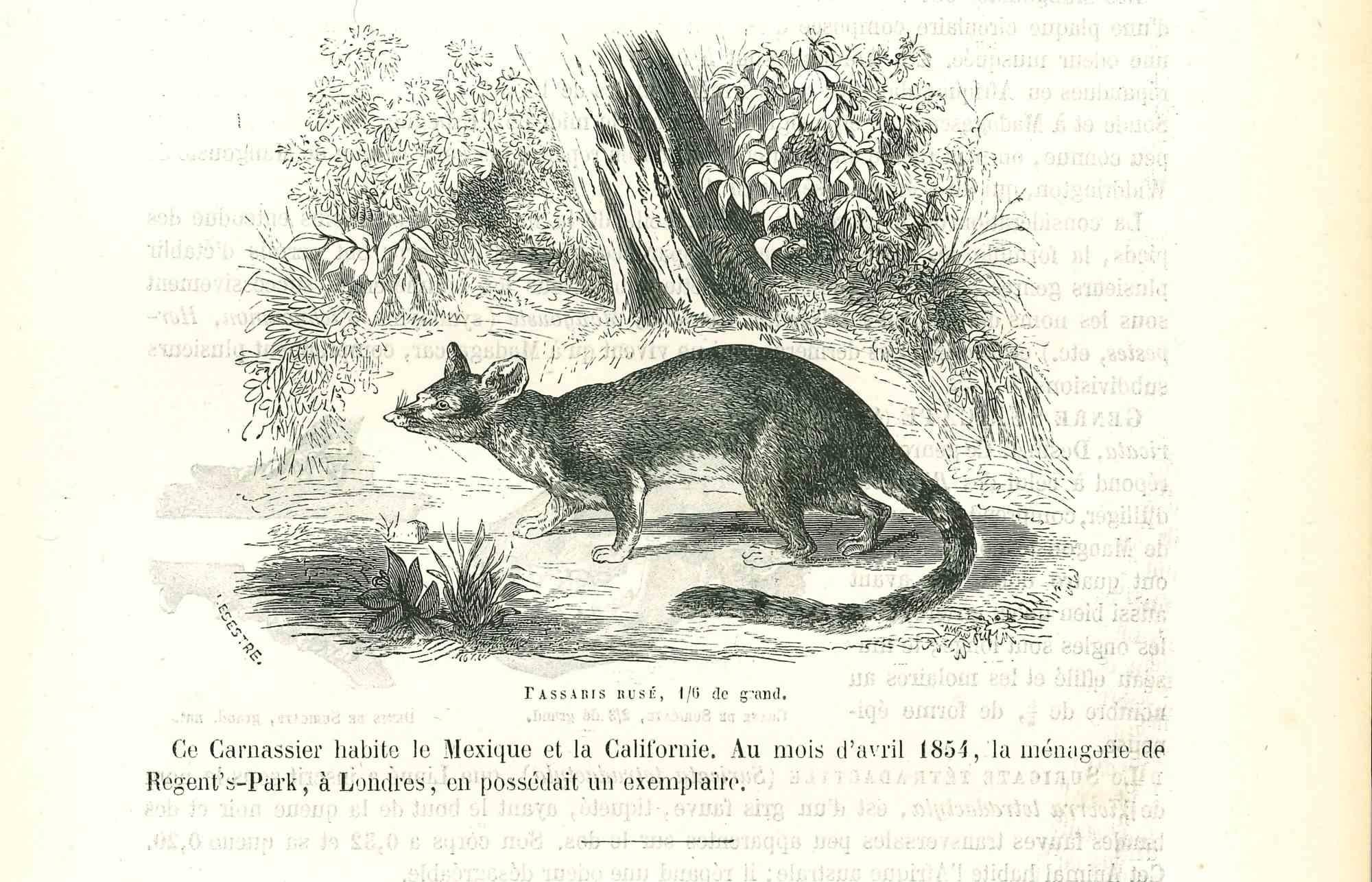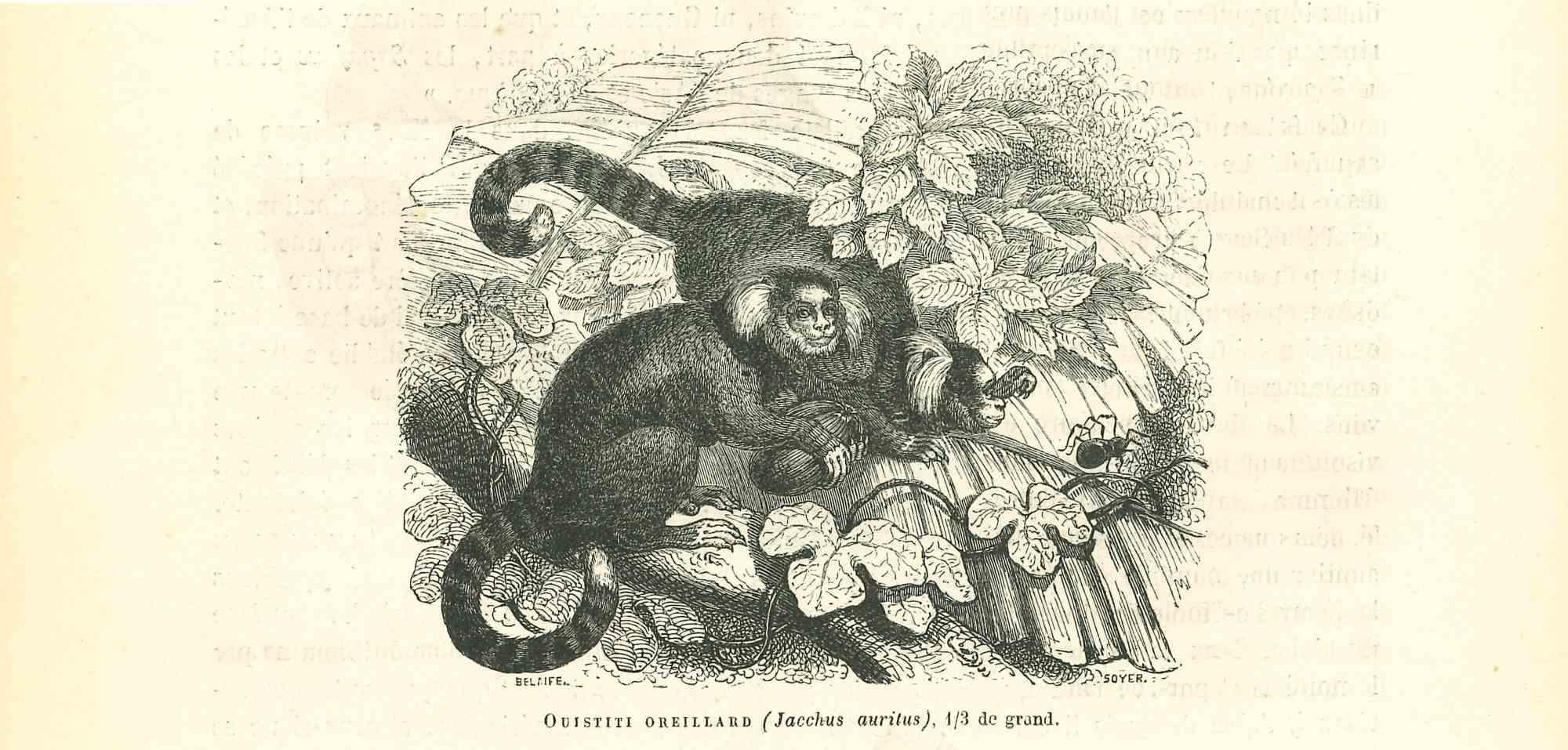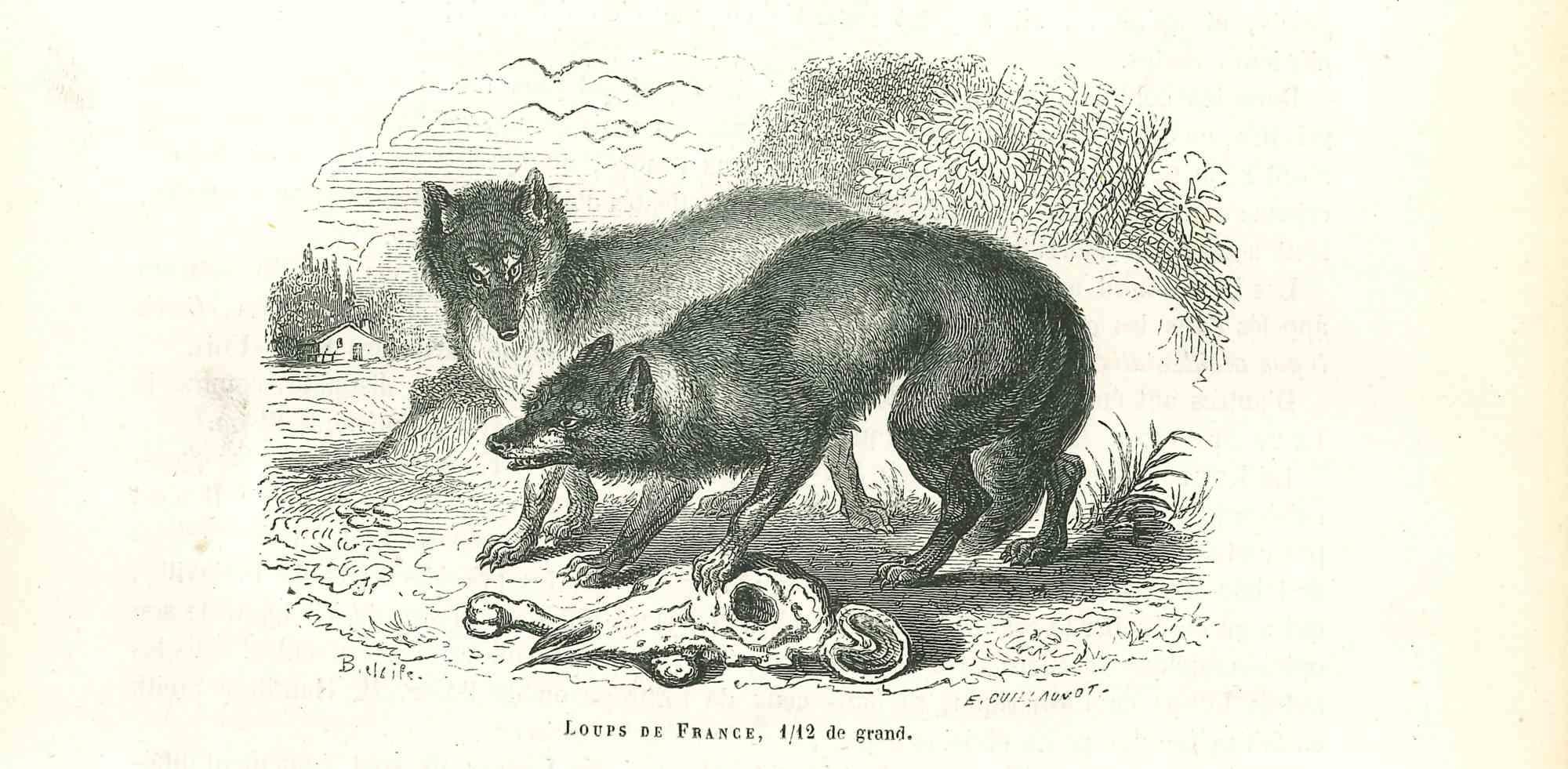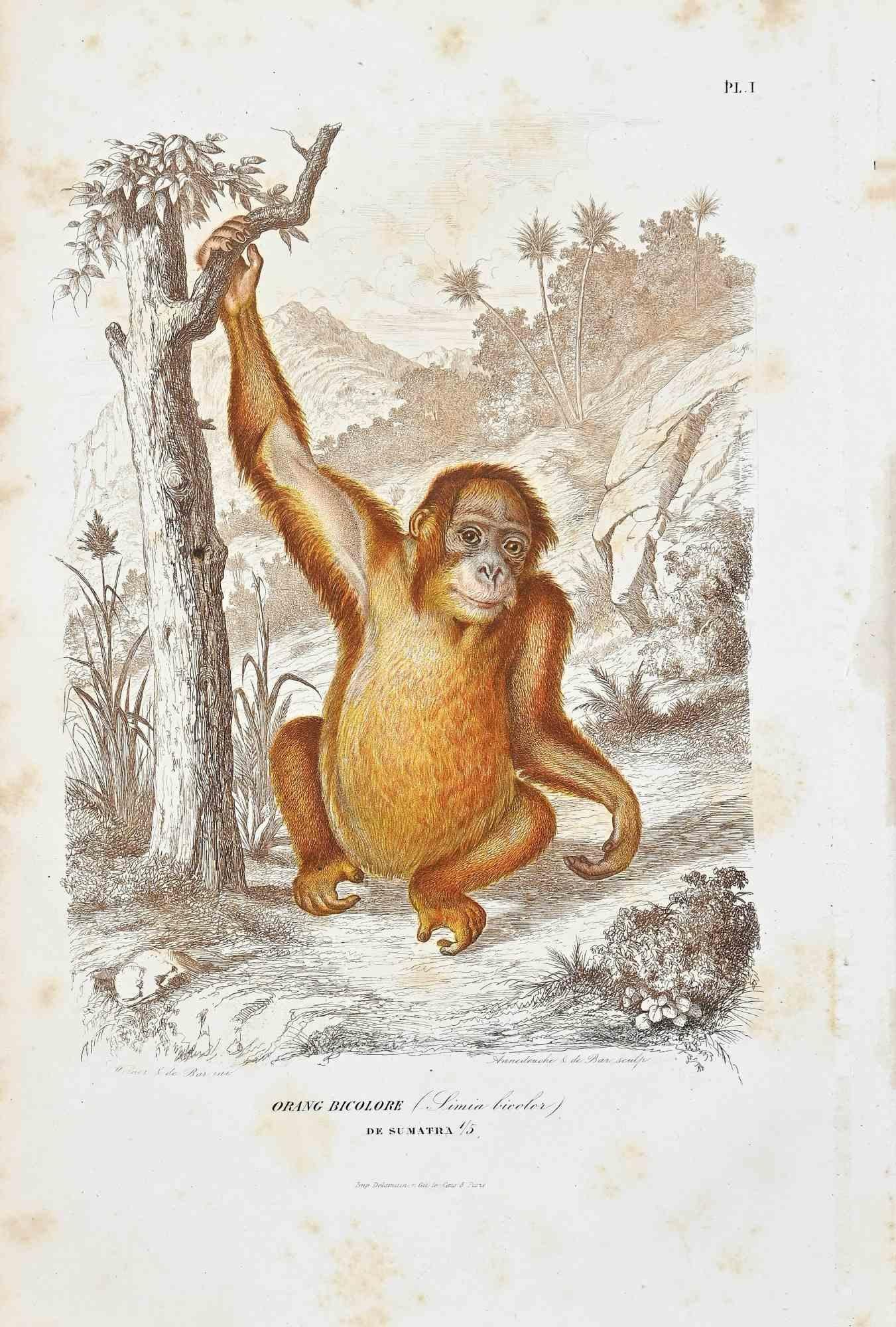Items Similar to The Monkeys - Original Lithograph by Paul Gervais - 1854
Want more images or videos?
Request additional images or videos from the seller
1 of 2
Paul GervaisThe Monkeys - Original Lithograph by Paul Gervais - 18541854
1854
About the Item
The Monkeys is an original lithograph on ivory-colored paper, realized by Paul Gervais (1816-1879). The artwork is from The Series of "Les Trois Règnes de la Nature", and was published in 1854.
Good conditions.
Titled on the lower. With the notes on the rear.
The series of artworks of "Les Trois Règnes de la Nature" represent animals through deft strokes and precise anatomical studies, which include its movement, behavior, shape, and structures of the body expressed at the same time aesthetically creatively and scientific too, usually with a beautiful landscape in the perspective or in the picturesque scenery.
Paul Gervais (Paris, 26 September 1816 - 10 February 1879) was a French zoologist and paleontologist, obtained a doctorate in science and medicine, obtained a doctorate in science and medicine from 1841 he opened the Department of Zoology and Anatomy compared to the Faculty of Science of Montpellier, where he presided over in 1856. Between 1848 and 1852 he received his important opera French Zoology and Paleontology.
- Creator:Paul Gervais (French)
- Creation Year:1854
- Dimensions:Height: 2.17 in (5.5 cm)Width: 6.89 in (17.5 cm)Depth: 0.04 in (1 mm)
- Medium:
- Movement & Style:
- Period:
- Framing:Framing Options Available
- Condition:Insurance may be requested by customers as additional service, contact us for more information.
- Gallery Location:Roma, IT
- Reference Number:Seller: T-1265471stDibs: LU65039403442
Paul Gervais
Paul Gervais (Paris, 26 September 1816 - 10 February 1879)
About the Seller
4.9
Platinum Seller
These expertly vetted sellers are 1stDibs' most experienced sellers and are rated highest by our customers.
1stDibs seller since 2017
6,839 sales on 1stDibs
Typical response time: 3 hours
- ShippingRetrieving quote...Ships From: Monaco, Monaco
- Return PolicyA return for this item may be initiated within 14 days of delivery.
Auctions on 1stDibs
Our timed auctions are an opportunity to bid on extraordinary design. We do not charge a Buyer's Premium and shipping is facilitated by 1stDibs and/or the seller. Plus, all auction purchases are covered by our comprehensive Buyer Protection. Learn More
More From This SellerView All
- Vous ne le croirez pas ma chère? - Lithograph by J.J. Grandville - 19th CenturyLocated in Roma, ITVous ne le croirez pas ma chère? is an original lithograph on ivory-colored paper realized by J.J. Grandville in the 19th Century. Good Conditions. Jean Ignace Isidore Gérard (13 S...Category
1850s Modern Figurative Prints
MaterialsLithograph
- Poinies dans la Prairie - Lithograph - 20th CenturyLocated in Roma, ITPoinies dans la Prairie is an original Lithograph, realized by an anonymous artist in the 20th Century. The status of preservation Good. The artwork is de...Category
Late 20th Century Modern Figurative Prints
MaterialsLithograph
- Innocent Mrs. Cat In The Court - Lithograph by J.J Grandville - 1852By Jean Jeacques GrandvilleLocated in Roma, ITInnocent Mrs. Cat In The Court is an original lithograph on ivory-colored paper realized by J.J. Grandville from Scènes de la vie privée et publique des animaux, 1852. Published by M...Category
1850s Modern Animal Prints
MaterialsLithograph, Paper
- Chevaux en Liberté - l Lithograph - 20th CenturyLocated in Roma, ITChevaux en Liberté is an original Lithograph, realized by an anonymous artist in the late 20th Century. The status of preservation Good. The artwork is de...Category
Late 20th Century Modern Figurative Prints
MaterialsLithograph
- The Lawyer Bunny In A Hurry - Lithograph by J.J Grandville - 1852By Jean Jeacques GrandvilleLocated in Roma, ITThe Lawyer Bunny In A Hurry is an original lithographs on ivory-colored paper realized by J.J. Grandville from Scènes de la vie privée et publique des anima...Category
1850s Modern Animal Prints
MaterialsLithograph, Paper
- Elephant - Original Lithograph by Emmanuel Gondouin - 1930sLocated in Roma, ITElephant is an original lithograph realized in the early 1930s by Emmanuel Gondouin, (Versailles, 1883 - Parigi, 1934) The artwork is depicted through strong strokes and is part of...Category
1930s Modern Animal Prints
MaterialsLithograph
You May Also Like
- “Le Picador II” from the book SabartésBy Pablo PicassoLocated in Collonge Bellerive, Geneve, CH“Le Picador II” from the book Sabartés, “A los Toros avec Picasso“ 1961, from the edition of unknown size, printed by Mourlot Frères, Paris, published b...Category
1960s Modern Animal Prints
MaterialsLithograph
- Le Christ a l'Horloge, ParisBy Marc ChagallLocated in Missouri, MOMarc Chagall "Le Christ a l'Horloge, Paris" (Christ in the Clock) 1957 (M. 196) Color Lithograph on Arches Wove Paper Signed in Pencil "Marc Chagall" Lower Right Initialed "H.C." (Hors Commerce) Lower Left, aside from numbered edition of 90 *Floated in Gold Frame with Linen Matting, UV Plexiglass Sheet Size: 18 3/4 x 14 3/4 inches (47.5 cm x 38 cm) Image Size: 9 3/4 x 8 1/2 inches Framed Size: 28.5 x 24.25 inches Marc Chagall was a man of keen intelligence, a shrewd observer of the contemporary scene, with a great sympathy for human suffering. He was born on July 7, 1887 in Vitebsk, Russia; his original name was Moishe Shagal (Segal), but when he became a foremost member of the Ecole de Paris, he adopted French citizenship and the French spelling of his name. Vitebsk was a good-sized Russian town of over 60,000, not a shtetl. His father supported a wife and eight children as a worker in a herring-pickling plant. Sheltered by the Jewish commandment against graven images, the young Chagall never saw so much as a drawing until, one day, he watched a schoolmate copying a magazine illustration. He was ridiculed for his astonishment, but he began copying and improvising from magazines. Both Chagall's parents reluctantly agreed to let him study with Yehuda Pen, a Jewish artist in Vitebsk. Later, in 1906, they allowed their son to study in St. Petersburg, where he was exposed to Russian Iconography and folk art. At that time, Jews could leave the Pale only for business and employment and were required to carry a permit. Chagall, who was in St. Petersburg without a permit, was imprisoned briefly. His first wife, Bella Rosenfeld, was a product of a rich cultivated and intellectual group of Jews in Vitebsk. Chagall was made commissar for the arts for the area, charged with directing its cultural life and establishing an art school. Russian folklore, peasant life and landscapes persisted in his work all his life. In 1910 a rich patron, a lawyer named Vinaver, staked him to a crucial trip to Paris, where young artists were revolutionizing art. He also sent him a handsome allowance of 125 francs (in those days about $24) each month. Chagall rejected cubism, fauvism and futurism, but remained in Paris. He found a studio near Montparnasse in a famous twelve-sided wooden structure divided into wedge-shaped rooms. Chaim Soutine, a fellow Russian Jew, and Modigliani lived on the same floor. To Chagall's astonishment, he found himself heralded as one of the fathers of surrealism. In 1923, a delegation of Max Ernst, Paul Eluard and Gala (later Salvador Dali's wife) actually knelt before Chagall, begging him to join their ranks. He refused. To understand Chagall's work, it is necessary to know that he was born a Hasidic Jew, heir to mysticism and a world of the spirit, steeped in Jewish lore and reared in the Yiddish language. The Hasidim had a special feeling for animals, which they tried not to overburden. In the mysterious world of Kabbala and fantastic ancient legends of Chagall's youth, the imaginary was as important as the real. His extraordinary use of color also grew out of his dream world; he did not use color realistically, but for emotional effect and to serve the needs of his design. Most of his favorite themes, though superficially light and trivial, mask dark and somber thoughts. The circus he views as a mirror of life; the crucifixion as a tragic theme, used as a parallel to the historic Jewish condition, but he is perhaps best known for the rapturous lovers he painted all his life. His love of music is a theme that runs through his paintings. After a brief period in Berlin, Chagall, Bella and their young daughter, Ida, moved to Paris and in 1937 they assumed French citizenship. When France fell, Chagall accepted an invitation from the Museum of Modern Art to immigrate to the United States. He was arrested and imprisoned in Marseilles for a short time, but was still able to immigrate with his family. The Nazi onslaught caught Chagall in Vichy, France, preoccupied with his work. He was loath to leave; his friend Varian Fry rescued him from a police roundup of Jews in Marseille, and packed him, his family and 3500 lbs. of his art works on board a transatlantic ship. The day before he arrived in New York City, June 23, 1941, the Nazis attacked Russia. The United States provided a wartime haven and a climate of liberty for Chagall. In America he spent the war years designing large backdrops for the Ballet. Bella died suddenly in the United States of a viral infection in September 1944 while summering in upstate New York. He rushed her to a hospital in the Adirondacks, where, hampered by his fragmentary English, they were turned away with the excuse that the hour was too late. The next day she died. He waited for three years after the war before returning to France. With him went a slender married English girl, Virginia Haggard MacNeil; Chagall fell in love with her and they had a son, David. After seven years she ran off with an indigent photographer. It was an immense blow to Chagall's ego, but soon after, he met Valentine Brodsky, a Russian divorcee designing millinery in London (he called her Fava). She cared for him during the days of his immense fame and glory. They returned to France, to a home and studio in rustic Vence. Chagall loved the country and every day walked through the orchards, terraces, etc. before he went to work. Chagall died on March 28, 1985 in the south of France. His heirs negotiated an arrangement with the French state allowing them to pay most of their inheritance taxes in works of art. The heirs owed about $30 million to the French government; roughly $23 million of that amount was deemed payable in artworks. Chagall's daughter, Ida and his widow approved the arrangement. Written and submitted by Jean Ershler Schatz, artist and researcher from Laguna Woods, California. Sources: Hannah Grad Goodman in Homage to Chagall in Hadassah Magazine, June 1985 Jack Kroll in Newsweek, April 8, 1985 Andrea Jolles in National Jewish Monthly Magazine, May 1985 Michael Gibson...Category
1950s Modern Figurative Prints
MaterialsLithograph
- Horses #IVBy Hoi LebadangLocated in San Francisco, CAThis artwork "titled "Horses #IV" 1974 is an original color lithograph, with embossing by French/Vietnamese artist Hoi Lebadang, 1922-2015. It is hand sig...Category
Late 20th Century Modern Animal Prints
MaterialsLithograph
- Alfred Bendiner, The Son also RaisesBy Alfred BendinerLocated in New York, NYNo matter the seriousness (or lack thereof) of the subject, everything is always beautifully drawn on the lithographic stone by Bendiner. Here a bull fight has gone amiss. Perhaps ...Category
1940s American Modern Animal Prints
MaterialsLithograph
- Alfred Bendiner, On VacationBy Alfred BendinerLocated in New York, NYNo matter the seriousness (or lack thereof) of the subject, everything is always beautifully drawn on the lithographic stone by Bendiner. In this 'Day at the Beach' scene Bendiner h...Category
1940s American Modern Animal Prints
MaterialsLithograph
- 'Circular Motion' original lithograph signed by Georges SchreiberBy Georges SchreiberLocated in Milwaukee, WIIn this lithograph, Georges Schreiber focused on the thrill of the circus, taking its circular composition from the central ring. Here, acrobats perform amazing feats of agility on t...Category
1940s American Modern Animal Prints
MaterialsLithograph
Recently Viewed
View AllMore Ways To Browse
Antique Monkey
Antique Monkeys
Monkey Original
French Monkey
Antique Monkey Art
Antique Monkey Prints
Antique Print Monkey
Sequence Dresses
Studio M Vintage Posters
Toulouse Lautrec Moulin Rouge
Venice Pen And Ink
Vintage 1940s Pin Up
Vintage Car Wash
Vintage Dresses Manhattan
Vintage Fruit Dress
William Turner Sculpture
Window Flower Pots
Winter In The Country Plate
